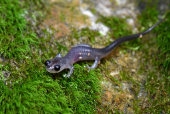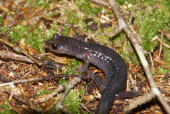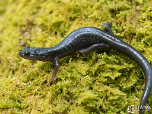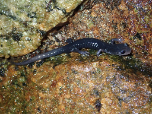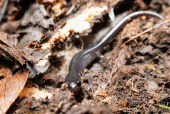Southern Gray-Cheeked Salamander (Plethodon metcalfi)
Description: There are four species of grey-cheeked salamanders, all of which are dark grey with lighter grey cheek patches. There are no white or red markings anywhere on the body. The four species of grey-cheeked salamanders appear essentially identical and are best identified by location. Southern grey-cheeked salamanders and northern grey-cheeked salamanders have the widest ranges and are essentially separated by the French Broad River. Blue Ridge grey-cheeked salamanders are found in a small area to the east of the southern grey-cheeked salamander. South Mountain grey-cheeked salamanders occur only in the South Mountains and are found in just two counties in North Carolina.
Habitat: Grey-cheeked salamanders are generally found only in forests in mountainous terrain. This highly-terrestrial species is often found under rocks, logs, or debris on the forest floor. These salamanders are most easily detected at night, especially under wet conditions, as individuals wander the forest floor in search of food. In some parts of their range, grey-cheeked salamanders may also be found in rock crevices.
Range: Plethodon metcalfi occurs along the border between North and South Carolina near Georgia. They mostly occur between Highlands, North Carolina in the west, Hendersonville, North Carolina in the north, and Greenville, South Carolina in the south.
Found in these States:
GA |
NC |
SC
Diet: Grey-cheeked salamanders consume primarily small forest floor invertebrates.
Reproduction: Nests of grey-cheeked salamanders have never been found. It is likely that they lay their eggs in underground cavities during late spring or early summer. Females of most closely-related species will guard their eggs until hatching and it is thought that grey-cheeked salamander females probably do the same. Grey-cheeked salamander hatchlings do not go through an aquatic larval stage. Instead, when young salamanders emerge from their eggs they look like miniature adults.
Status: Listed as Least Concern since, although its extent of occurrence (EOO) is estimated at 11,224 km2, it is common and reasonably adaptable with a presumed large population.
»» Kingdom: Animalia - Animals
»» Phylum: Chordata - Chordates
»» Subphylum: Vertebrata - Vertebrates
»» Class: Amphibia - (Amphibians)
»» Order: Caudata - Salamanders
»» Family: Plethodontidae - Lungless Salamanders
»» Genus: Plethodon
»» Species: Plethodon metcalfi - Southern Gray-Cheeked Salamander
This article uses material from the Wikipedia article "Southern Gray-Cheeked Salamander", which is released under the Creative Commons Attribution-Share-Alike License 3.0. Content may have been omitted from the original, but no content has been changed or extended.
|



